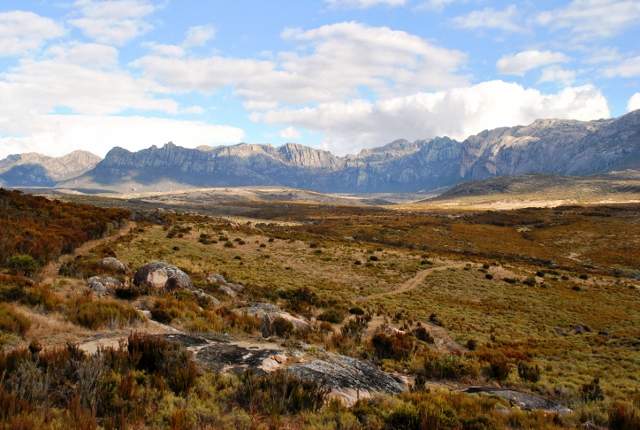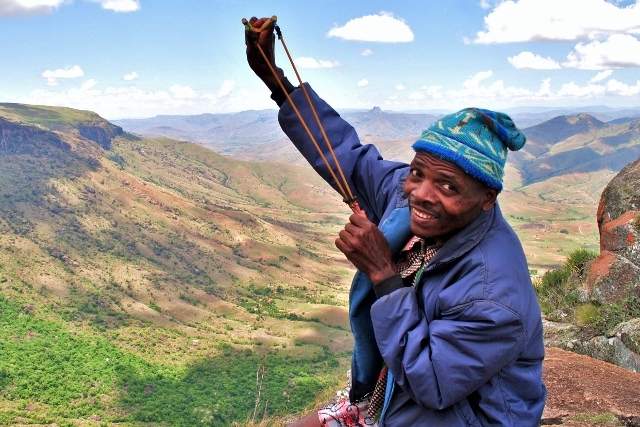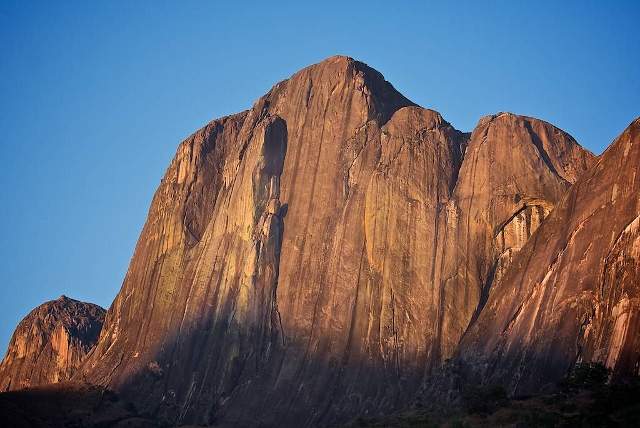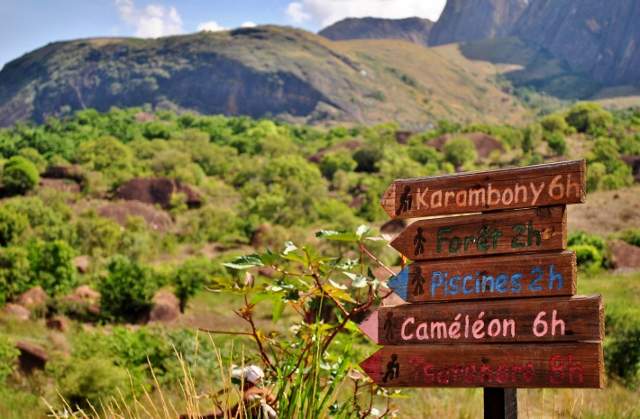Why travel to Andringitra?
Travel to Madagascar, and Andringitra in particular, is a rugged adventure sure to pique the interest of Indie travelers. A spectacular array of landscape changes, animals, and plants lie within the park boundaries, but equally awe-inspiring are the stories of the Malagasy living in and around Andringitra. Their ability to turn their home into an off the beaten path travel destination (with the help of a couple outside organizations) and directly improve the local economy is a considerable success in a country currently facing so many problems with development and political stability. Travelers to the area should feel confident that their visit not only benefits their wanderlust, but also the local quality of life.
From farming to entrepreneurship: the start of tourism in Andringitra

When visitors enter the Sahanambo valley adjacent to Andringitra National Park in the southern highlands of Madagascar, the world outside feels distant and irrelevant. Terraced rice fields and distant mountain ranges line the one dirt road that runs out of the small market town and last stop on the bus route, Vohitsaoka, to the park entrance. Small, dust-coated children race from nearby clusters of mud huts to the road to shout “Salam!” at curious-looking tourists – their greeting in Malagasy rather than French – one of many testaments to how self-sustained life in the valley is.
The same claim could be made about Andringitra’s tourist industry. Although the park itself was founded with the collaboration of WWF, an international organization, and its Malagasy partner ANGAP in 1999, the creation of its hotels and infrastructure for nearby excursions has been a bottom-up, grassroots endeavor. It could not have happened without the close involvement of locals, who mostly were – and still are – farmers or cow-herders. Currently, Madagascar National Parks hires guides and porters born and raised in the area and who have an intimate familiarity with the land. Two of the camps below the climbers’ haven, the Tsaranoro massif, were established and run locally, while the third, more luxurious of the pack (Camp Catta) is an offshoot of a Fianaratsoa-based hotel company.
Needless to say, tourism in Andringitra has a direct impact on economic development in the area and relies heavily on its homegrown resources. One could even argue that because of locals’ deeply rooted involvement, they have avoided changing the character of the valley the way tourism in some places has transformed quaint fishing villages into built-up vacation hotspots.
Check out author Jessie Beck’s traveler profile, and fill one out, too!
Trekking and hiking

What to expect
On a cool, clear August afternoon, two Spanish tourists sat slumped against the park office in Morarano. This is where they, like most trekkers traveling by public transportation and unable to easily access the other park entrance, began and ended the multi-day trek to the park’s famed Pic Imarivolanitra (also known as Pic Boby, but since its namesake was a dog who allegedly summited before its owner, “Boby” is considered offensive by local Malagasy). The rocky summit stands at 8671 feet (2643m) tall and has earned the title of highest accessible peak in Madagascar. “But first you have to climb up these really tall stairs,” one of the Spanish girls said, “Our guide said there are a million of them,” the other added. The exhaustion in their faces seemed to say that “a million” might be a low estimate.
Some locals have never left, never seen a flush toilet, and never experienced electricity – a hard to imagine concept in our own technology-obsessed era. For the open-minded traveler, catching a glimpse of this lifestyle could be just as powerful and eye-opening as the area’s incredible landscapes.
The hike begins with an easy enough walk across rice fields and villages before embarking on a steep ascent on a long, rocky staircase. There are no switchbacks, and the initial hours of straight incline make it a truly difficult hike. However, while you may find yourself panting under the weight of your pack, pausing to stare out over an endless vista of green fields or a forest of palms, groups of locals will amicably pass by. Seeing Malagasy women darting up the mountain with small children perched on their shoulders or a goony sack of rice on their heads while wearing cheap plastic sandals or no shoes at all will make your fatigue appear laughable.
Seeing Malagasy use these same trails to access other villages adds to the charm of the hike. Hikers aren’t just challenging themselves physically, but also following the footsteps of residents visiting friends and family, at times winding through villages and learning firsthand how remote and hard to reach these places are. Some locals have never left, never seen a flush toilet, and never experienced electricity – a hard to imagine concept in our own technology-obsessed era. For the open-minded traveler, catching a glimpse of this lifestyle could be just as powerful and eye-opening as the area’s incredible landscapes.
Practical considerations

While by far the most popular, the circuit to Pic Imarivolanitra (15.5 miles – 25km round trip, taking about 2 days) is not the only hiking option. Within the park are also:
- The less challenging Asaramanitra – 3.1 mile (6km), about 4 hours
- Diavolana – 8 mile (13km), about 10 hours
- A trek to the lemur-abundant Imaitso – 8.5 miles (14km), about 8 hours.
- For visitors primarily interested in rock climbing near the Tsaranoro Massif, Le Chameleon (4-8 hours depending on return circuit), offers a decently tough hike through a forest filled with lemurs to the top of the chameleon-shaped rock overlooking the Massif. More information about hiking circuits can be found in the park brochure.
Gear: It is possible to rent tents and other gear for trekking at Camp Catta, but no matter what others may tell you, the guide office in Morarano does not provide any equipment. The office has enough trouble providing its guides with adequate tents, sleeping bags, shoes, and backpacks, and should you be inclined, donations of this sort make a huge difference in their quality of work. Ideally, hikers should bring their own gear, including all food and water needed.
Weather: Hikers should also be prepared for bad weather at any time of the year. During the dry, winter months of June, July, and August temperatures can drop to as low as 20F (-7C) inside the park, but reach up to 77F (25C) other times of the year. Heavy rains make the whole region difficult to access in January and February, but rain is rare from June-October.
Rock climbing

What to expect
The valley just outside of Andringitra National Park, predominately in and around the Tsaranoro Massif, has sublime single and multi-pitch climbing routes. While many are already bolted, there is still much room for development and first ascents. As climbers may expect from such a large and looming rock-face like Tsaranoro (Tsa-RA-nu-ru), the routes can be long and challenging.
According to Hery, the region’s one climbing guide, reaching the top of the massif takes two days to complete. “I have often sleep there” he said, grinning widely and pointing to a small ledge halfway up the Tsaranoro Be section of the rock, “that route is for champions.”
A scattering of boulders and shorter routes on the right side of Tsaranoro, however, are better suited for the average and inexperienced, those of us who haven’t earned the right to call ourselves champions. Topography maps can be found online.
By staying in one place, climbers get a better insight on village life than trekkers, but also the effect tourism has had on the valley. These are especially evident in the village neighboring Camp Catta. The effects may be subtle, but they have taken advantage of the trickle of tourists by setting up a store that sells souvenirs and basics, like beer, rice, bottled water, and the occasional vegetable, from a small storefront.
Compared with the total lack of amenities in Morarano, where trekkers pass through to visit the park office and hire guides, even these simple services stand out as unique. This village caught on to the fact that a hungry traveler will buy a pack of crackers and bottle of water and have benefitted from it. Not only that, but they have demonstrated how tourist services have been a grassroots endeavor that directly supports the valley’s economy. Chances are, you are even buying your rice from the family who grew it.
Practical considerations

Most climbers visiting Tsaranoro are both experienced and bring their own ropes, harnesses, and the like. For those without experience or equipment, Camp Catta can help set you up with the locally born climbing guide, Hery (who also leads paragliding tours) and any equipment you might need.
Even if you have equipment, it’s not a bad idea to have a guide lead you to the base of the rock since trails aren’t well marked, and it can take up to 40 minutes to hike from the camps to the rock. Climbers planning to hunker down and explore the rock for a few days or weeks have an advantage over trekkers in that they can be more relaxed about packing in all of their food. Basics like rice and oil can be bought in the small village next to the camp, and Camp Catta has a restaurant complete with cold beer and homemade bread. Soa Camp is the best option for self-catering climbers as well as a great opportunity to meet one of the entrepreneurial farmer/hotel owners the valley has turned out.
The nitty-gritty of traveling to Andringitra

Getting there
For independent travelers taking public transportation, the park and Tsaranoro Massif are best accessed on the Sahanambo Valley side of the park. To get here:
- First take a taxi-brousse, or public bus, from Fianaratsoa to Ambalavao (1.5 hours, 2,500 Ariary / $1.25 USD). Ambalavao is also a great place to pick up food and supplies.
- From Ambalavao take another bus to the market town of Vohitsaoka (1.5 hours, 3,000 Ariary / $1.50 USD) – the main market is on Saturdays. Tourists have to pay a small fee upon entering Vohitsaoka (3,000 – 4,000AR / $1.50 – 2 USD).
- From there, you will have to walk 2-3 hours to the Tsaranoro Massif where most of the camps in Sahanambo are.
- From there it’s another 5km to the park office in Morarano.
- There is no public transportation from Vohitsaoka but Camp Catta sometimes runs a shuttle in the peak tourist season from June thru August.
Confused? Here’s a map.
Where to stay

At the base of the Tsaranoro massif, there is a cluster of three camps.
- The most expensive, Camp Catta, also offers the most modern amenities, such as hot water, electricity, and a restaurant with western cuisine. Bungalows with actual beds, as well as tents with mattresses can be rented here.
- The other two offer basic tent and mattress accommodation and are better suited for travelers who want to cook for themselves.
- Soa Camp, directly below Camp Catta and next to the village school, is the better option of the two. It does not have electricity but they sometimes run a generator at night.
- In Morarano, it is possible to pitch your own tent next to the park office for a small fee (10,000AR / $5USD).
Health & Safety
While Andringitra National Park is a relatively safe place to visit, there are still a few things travelers should keep in mind. In terms of health, there is a basic clinic nearby, but the nearest hospital is Fianaratsoa. Malaria, while less prevalent in the Madagascar highlands, is still a threat and prophylaxis is recommended. Tourists should also be aware of a group of cow thieves known as dahalo (da-HA-lu) are active in the south. We assume you won’t be bringing a cow along, but beware of leaving valuables unattended in your tent. Otherwise, Andringitra, like the rest of Madagascar, is blissfully lacking in nasty predators and poisonous vermin.
Overview of Costs

Note: the local currency is Ariary (AR) but Malagasy still sometimes quote prices in the old Franc (FMG). 1 Ariary = 5 francs.
- Taxi-brousse from Fianaratsoa – Ambalavao -2,500 AR / $1.25 USD
- Taxi-brousse from Ambalavao – Vohitsaoka – 3,000AR / $1.50 USD
- Entrance fee to Vohitsaoka – 3,000 – 4,000AR / $1.50 – 2.00 USD
- Camp Catta – 7,500AR / $3.75 USD to pitch a tent; 17,000AR / $8.50 for tent with mattress; 63,000AR / $31.00 USD for a bungalow with twin bed (Website: https://www.campcatta.com/hebergement.htm)
- Soa Camp – 15,000AR per tent / $7.50USD
- A bottle of water – 2,000 – 3,000 AR / $1 – 1.50 USD
- A beer – 2,000 – 5,000 AR / $1 – $2.50 USD
- A cup of rice – 300 AR / $0.15 USD
- A small pile of vegetables – 100-300 AR / $0.05 – 0.15 USD
- Climbing guide – 50,000AR / $25 USD per day per person
- Trekking guide – Park fees are 10,000AR / $5 USD and guide fees start at 15,000AR / $7.50USD and go up depending on the trekking circuit.
Indie trips to Madagascar
For those of you looking to add Madagascar to a longer trip, check out the following trip that includes an extensive leg in southern Africa. By registering for Indie, you can completely customize this trip to make it your own. Change the city of origin, the locations in the itinerary, and dates around to fit your specific needs, click “search fares,” and get a price instantly!
To find out more about traveling in Madagascar, check out the following articles and resources:
- Check out our Madagascar Indie Travel Guide
- Read How to Be an Independent Backpacker in Madagascar
- Read why Madagascar is on our list of Top Destinations for Indie Travelers in 2013
- Find a flight to Madagascar
- Check out adventure trips in Madagascar